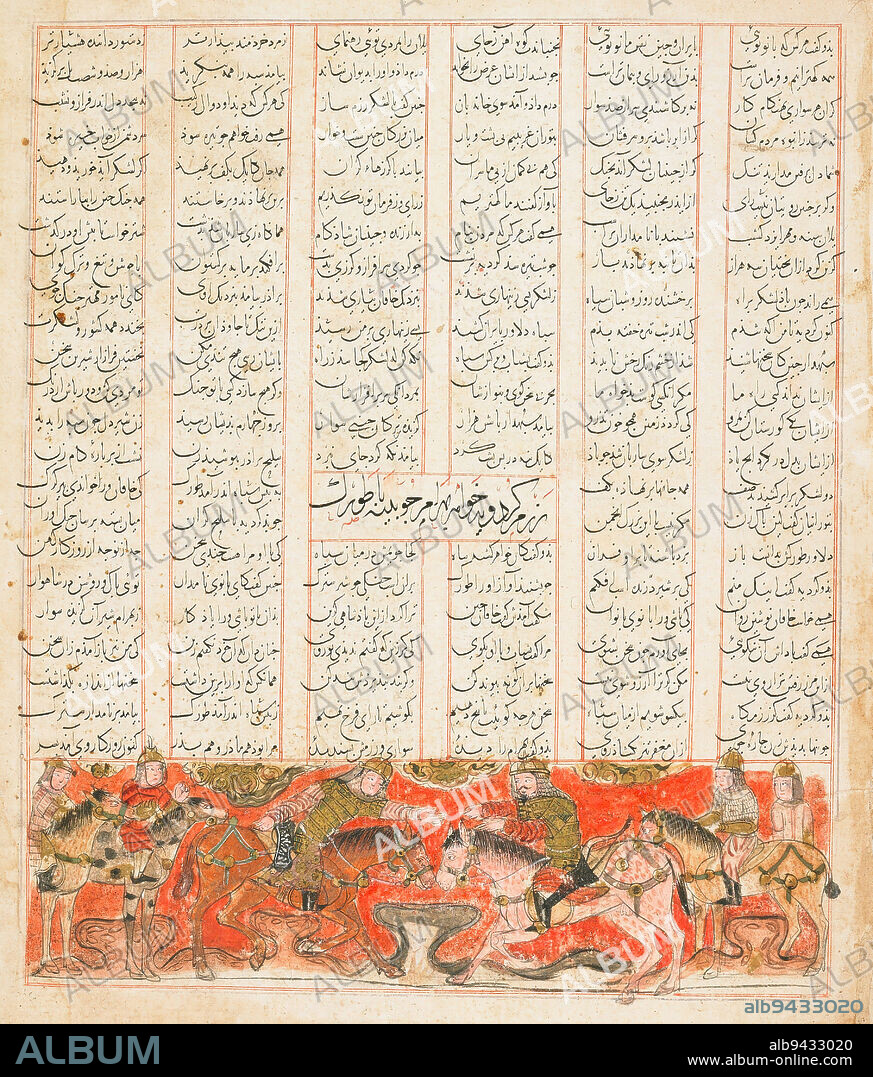alb9433020
Gordiya Parleys with Tuwurg, 1341, Hasan ibn Muhammad ibn `Ali ibn Husaini (known as al-Mausili), 13 x 8 1/8 in. (33.02 x 20.64 cm) (sheet), Ink, colors, and gold on paper, Iran, 14th century, This page, from the same Shahnameh manuscript as the work on the left, shifts the image to the bottom of the six-columned text, demonstrating the variety and visual rhythm of the complete manuscript. The scene depicts the influential Iranian noblewoman Gordiya, seen on horseback on the left. Her late brother Bahram had attempted to seize the throne from the Sasanian emperor Khosrow II (r. 590628 CE). After Bahrams defeat, they fled to the court of the emperor of China who insisted on taking Gordiyas hand in marriage. Unwilling, Gordiya plans her escape; the emperor soon learns of Gordiays intentions and sends his military leader, Tuwurg, seen on the right, to bring her back. This painting, with its freewheeling composition of polo-like combat, foreshadows Gordiyas victory over Tuwrug, and her triumphant return to Iran, where she ultimately marries Khosrow II.

|
Añadir a otro lightbox |
|
Añadir a otro lightbox |



¿Ya tienes cuenta? Iniciar sesión
¿No tienes cuenta? Regístrate
Compra esta imagen.
Selecciona el uso:

Descripción:
Ver traducción automática
Gordiya Parleys with Tuwurg, 1341, Hasan ibn Muhammad ibn `Ali ibn Husaini (known as al-Mausili), 13 x 8 1/8 in. (33.02 x 20.64 cm) (sheet), Ink, colors, and gold on paper, Iran, 14th century, This page, from the same Shahnameh manuscript as the work on the left, shifts the image to the bottom of the six-columned text, demonstrating the variety and visual rhythm of the complete manuscript. The scene depicts the influential Iranian noblewoman Gordiya, seen on horseback on the left. Her late brother Bahram had attempted to seize the throne from the Sasanian emperor Khosrow II (r. 590628 CE). After Bahrams defeat, they fled to the court of the emperor of China who insisted on taking Gordiyas hand in marriage. Unwilling, Gordiya plans her escape; the emperor soon learns of Gordiays intentions and sends his military leader, Tuwurg, seen on the right, to bring her back. This painting, with its freewheeling composition of polo-like combat, foreshadows Gordiyas victory over Tuwrug, and her triumphant return to Iran, where she ultimately marries Khosrow II.
Personas:
Crédito:
Album / quintlox
Autorizaciones:
Modelo: No - Propiedad: No
¿Preguntas relacionadas con los derechos?
¿Preguntas relacionadas con los derechos?
Tamaño imagen:
3631 x 4259 px | 44.2 MB
Tamaño impresión:
30.7 x 36.1 cm | 12.1 x 14.2 in (300 dpi)
 Pinterest
Pinterest Twitter
Twitter Facebook
Facebook Copiar enlace
Copiar enlace Email
Email
